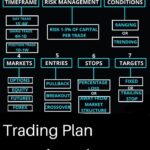Introduction
Leverage is a powerful tool in trading that allows traders to control large positions with a relatively small amount of capital. While it can amplify profits, it also increases potential losses. For beginners, leverage can seem like a shortcut to quick wealth—but without proper understanding and discipline, it can lead to significant losses and account blowouts.
In this article, we will explain what leverage is, how it works, the risks involved, and how to use it responsibly in your trading journey.
What is Leverage?
Leverage is the use of borrowed capital to increase the size of a trading position. It is expressed as a ratio, such as 10:1, 50:1, or even 500:1 depending on the broker and asset class.
For example, with 100:1 leverage, you can control a $100,000 trade with just $1,000 of your own money. The remaining $99,000 is effectively borrowed from the broker.
How Leverage Works: A Simple Example
Imagine you have $1,000 in your trading account, and you want to trade EUR/USD using 100:1 leverage.
- Without leverage: You can only buy $1,000 worth of EUR/USD.
- With 100:1 leverage: You can control a $100,000 position.
If the trade moves 1% in your favor, you would make $1,000 (100% return).
If it moves 1% against you, you would lose your entire $1,000 (100% loss).
This example illustrates how leverage can magnify both gains and losses.
Types of Leverage
- Broker-Provided Leverage
Offered by your broker and regulated based on the country.
Example:- EU/UK: Max 30:1 (for retail clients)
- USA: Max 50:1
- Some offshore brokers: Up to 1000:1
- Internal Leverage
Even without using high broker leverage, traders can “overleverage” by risking too much per trade relative to their capital. This is often more dangerous than using high external leverage.
Benefits of Using Leverage
- Access to Larger Positions
Allows traders to participate in markets with limited capital. - Potential for Higher Returns
Small price movements can result in significant gains. - Efficient Use of Capital
You can allocate funds across multiple trades or instruments instead of locking all capital into one.
Risks of Using Leverage
- Magnified Losses
Just as leverage multiplies gains, it also multiplies losses. One wrong move can wipe out your account. - Increased Volatility Exposure
Markets like forex or crypto can be highly volatile. Leverage increases sensitivity to price swings. - Margin Calls
If your losses reach a certain level, your broker may require you to deposit more funds or will close your positions automatically (stop-out). - Overconfidence
New traders often misuse leverage thinking it’s a shortcut to success.
Leverage and Risk Management
Using leverage wisely involves strict risk control. Here are key guidelines:
1. Use Lower Leverage by Default
Even if your broker allows 100:1 or more, consider using 5:1 or 10:1 until you are consistently profitable.
2. Limit Risk per Trade
Never risk more than 1-2% of your account on any single trade, regardless of leverage used.
3. Always Use a Stop-Loss
Define your maximum loss before entering a trade. This ensures that a leveraged trade doesn’t spiral out of control.
4. Understand the Margin Requirements
Learn how much capital is required to open and maintain your positions. Keep extra funds in your account to avoid forced liquidation.
Margin vs. Leverage: The Relationship
- Margin is the amount of money required to open a position.
- Leverage determines how much exposure you can get with that margin.
For example:
- 100:1 leverage means you need 1% margin.
- A $100,000 trade requires $1,000 in margin.
If the trade goes against you and your equity drops below the maintenance margin level, the broker may close your positions.
When Should You Avoid Leverage?
- When you’re new to trading
- During high-impact news events
- In highly volatile markets
- If you don’t have a clear stop-loss or risk plan
- When your emotions are controlling your decisions
Common Mistakes When Using Leverage
- Overtrading: Taking too many large positions simultaneously.
- No Stop-Loss: Trading without exit protection.
- Overconfidence: Letting a few wins encourage reckless risk.
- Ignoring Position Size: Using maximum leverage without calculating proper lot sizes.
- Using Full Margin: Risking your entire account on a few trades.
Tips for Safe Leverage Usage
- Start with a demo account to test leverage safely.
- Use the lowest leverage possible until you are consistently profitable.
- Monitor your margin level and avoid being close to a margin call.
- Focus on capital preservation, not just profit generation.
- Backtest strategies with and without leverage to understand the differences in performance and risk.
Conclusion
Leverage is neither good nor bad—it’s a tool. Like any powerful tool, it can help you succeed or destroy your progress if misused. Understanding how leverage works, managing your risk, and maintaining discipline are essential steps to becoming a professional trader.
If you’re just starting, it’s better to trade with low or no leverage until you fully understand your trading system and risk profile. Success in trading doesn’t come from using high leverage—it comes from smart decisions, risk control, and patience.


